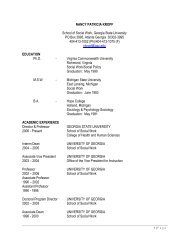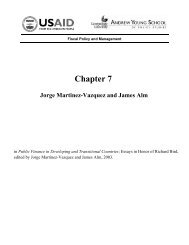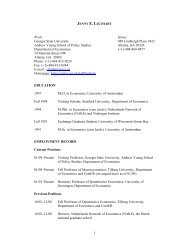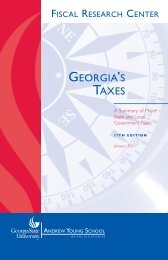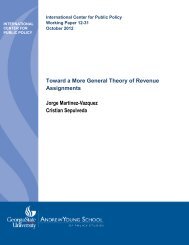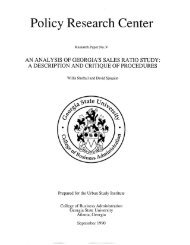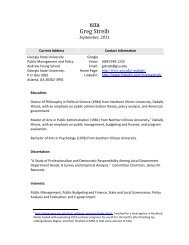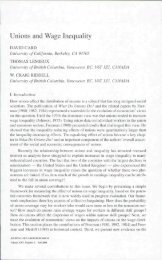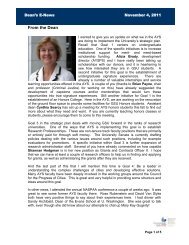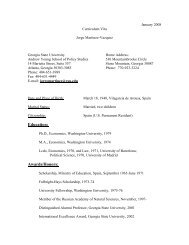Robin Boadway and Frank Flatters - Andrew Young School of Policy ...
Robin Boadway and Frank Flatters - Andrew Young School of Policy ...
Robin Boadway and Frank Flatters - Andrew Young School of Policy ...
You also want an ePaper? Increase the reach of your titles
YUMPU automatically turns print PDFs into web optimized ePapers that Google loves.
616 / <strong>Robin</strong> <strong>Boadway</strong> <strong>and</strong> <strong>Frank</strong> <strong>Flatters</strong><br />
represented by the utility function u(Xi, Gi/Li) where Xi is the per capita<br />
consumption <strong>of</strong> private goods, Gi is the quantity <strong>of</strong> public sector goods provided in<br />
province i, <strong>and</strong> GiLia is the services <strong>of</strong> the latter. The parameter a is an index <strong>of</strong> the<br />
'publicness' <strong>of</strong> provincial public services <strong>and</strong> can take values 0 a 1. This<br />
formulation allows us to span the spectrum from pure public goods to pure private<br />
goods since these correspond to a = 0 <strong>and</strong> a = 1 respectively.6 The public service<br />
would be 'impure' or 'partially rivalrous' to use Musgrave's (1969) term if a is<br />
between zero <strong>and</strong> unity. Assuming initially that the value <strong>of</strong> output <strong>of</strong> a province<br />
accrues entirely to its own residents, per capita private goods consumption Xi is given<br />
by [fi(Li) - GiLi]. Notice that we are ignoring any activity by the central or federal<br />
government.7<br />
Provincial government behaviour is easy to characterize in this simple model. Each<br />
one is assumed to behave myopically in the sense that it ignores the influence <strong>of</strong> its<br />
actions on migration. This assumption has been used almost universally in the<br />
literature on local public goods,8 <strong>and</strong> as we have mentioned, it does not affect the<br />
results <strong>of</strong> the model. Under this assumption, a provincial government that aims at<br />
maximizing the welfare <strong>of</strong> its citizens will solve the following problem:<br />
Max u[f(L) - GIL, GILa], (1)<br />
G<br />
where we shall follow the convention <strong>of</strong> dropping the provincial subscripts when<br />
analysing the behaviour <strong>of</strong> a representative province.<br />
The first-order condition for this unconstrained maximization problem yields:<br />
L(-a) UG/UX = 1, (2)<br />
where UG <strong>and</strong> ux are the marginal utilities <strong>of</strong> GILa <strong>and</strong> X respectively. If a = 0, this<br />
corresponds to the familiar Samuelson condition that the sum <strong>of</strong> the marginal rates <strong>of</strong><br />
substitution (MRS) equals the MRT (here unity). Similarly, if a = 1 it reduces to the<br />
optimality condition for pure private goods. The solution to (2) for G determines how<br />
provincial output is divided between private <strong>and</strong> public sectors. To characterize a<br />
migration equilibrium, we must examine how per capita utility in a province varies<br />
with population size.<br />
6 This is similar to the technique used by Borcherding <strong>and</strong> Deacon (1972) <strong>and</strong> Bergstrom <strong>and</strong><br />
Goodman (1973) in their empirical studies <strong>of</strong> local public expenditures in the U.S.A. Both papers<br />
found a close to unity. An alternative way to introduce impurity into public goods is to explicitly<br />
include congestion costs. See Buchanan <strong>and</strong> Goetz (1972), <strong>Flatters</strong>, Henderson, <strong>and</strong> Mieszkowski<br />
(1974), <strong>and</strong> Oakl<strong>and</strong> (1972) for examples <strong>of</strong> this approach. The former method is more convenient<br />
for our purposes but both yield qualitatively similar results.<br />
7 The structure <strong>of</strong> this model is similar to that found in much <strong>of</strong> the theoretical literature on the<br />
subject, except for our generalization to allow for impure public goods. See, for example, <strong>Flatters</strong>,<br />
Henderson, <strong>and</strong> Mieszkowski (1974), Stiglitz (1977), <strong>and</strong> the survey in Atkinson <strong>and</strong> Stiglitz<br />
(1980). Other models have used slightly different devices from the diminishing marginal product <strong>of</strong><br />
labour when applied to fixed l<strong>and</strong> to generate diseconomies <strong>of</strong> population increase. Buchanan <strong>and</strong><br />
Goetz (1972) use club goods (see also Henderson, 1974). Starrett (1980) used spatial considerations.<br />
In these alternative models the qualitative results derived in this section continue to hold.<br />
8 Exceptions to this are Boskin (1973), Pauly (1973), <strong>and</strong> the recent paper by Starrett (1980).



